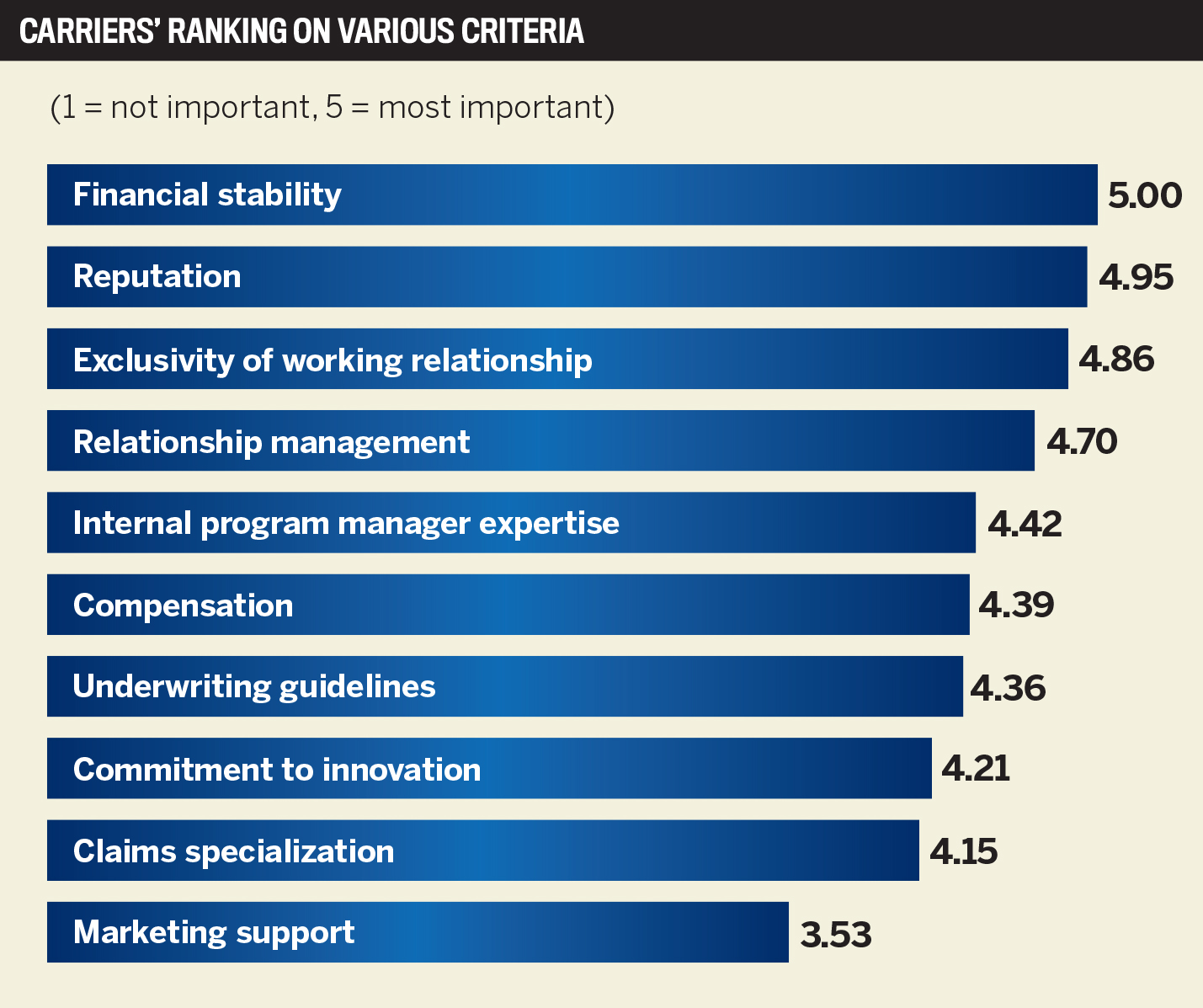5-Star Program Administrators and Carriers 2022

Jump to winners | Jump to methodology
Get with the program
The program business is booming following an estimated 30% rise in the past two years. There was over $53.8 billion in premium in 2020, according to Ray Scotto, executive director of the Target Markets Program Administrators Association (TMPAA).
“If the growth pattern shown over the past several years continues, we would estimate that the premium number at this point would be somewhere near $70 billion today,” he says. “There continues to be great enthusiasm about the program space, and we see many new program administrators and carriers entering the market.”
“ If the growth pattern shown over the past several years continues, we would estimate that the premium number at this point would be somewhere near $70 billion today”
Ray Scotto, Target Markets Program Administrators Association
According to the TMPAA’s most recent biennial study, program business is growing more quickly than the overall commercial insurance marketplace, with a 32.8% rise between 2018 and 2020 and the growth in direct premiums earned for commercial lines increasing by only 9.33% over the same period.
Program administrators and carriers have a symbiotic relationship. The former maintains a vital agent-facing role and day-to-day administration, while the latter offers financial stability and resources needed to keep coverage moving through unpredictable times.
Insurance Business America’s 5-Star Program Administrators and Carriers list in 2022 celebrates this mutually beneficial relationship. In addition to yearly premium growth, which averaged 35%, IBA judged program administrators on the largest programs, expertise and stability and innovations in program development. In turn, program administrators ranked carriers on criteria including exclusivity of relationship, carrier reputation and commitment to innovation.
Our data delivers a compelling snapshot inside the industry. Clear trends were revealed when the survey respondents ranked the criteria on a scale from 1 (not important) to 5 (extremely important). Sixty percent rated exclusivity of working relationship as extremely important, while 84% ranked claims specialization either a 4 or 5. Similarly definitive results were seen on the issue of relationship management, with 65% placing it as extremely important. A majority 86% of industry professionals ranked commitment to innovation in the top two tiers.
“With each of our program administrator partners, we share the goal of building something special. And that’s what makes it fun”
Chris Bressette, AXA XL
Continuous improvement
AXA XL is one of the carrier winners. The leader of the company’s North American delegated authority P&C programs unit, Chris Bressette, notes the exponential interest in programs in recent years.
“A growing number of traditional carriers have adopted a much more technical view of risk across multiple lines and are subject to increasingly complex internal governance structures due to the delegated model,” he says. “In that environment, carrier experience makes a huge difference. In contrast, fronting markets have facilitated the entry of more start-up program administrators and have broadened the participation of non-traditional reinsurers.”
Scotto agrees with this analysis and adds, “The most notable increase in program capacity is coming from new fronting or hybrid fronting carriers.” Fronting is when an insurer issues a policy for a self-insured organization or captive insurer transferring the risk to an indemnity or reinsurance agreement.
Support of the fronting market has been a relatively easy road to growth for reinsurers, according to a recent report from Conning.
“Those who use [fronting] either occasionally or frequently (31%) say fronting provides them more flexibility and allows them to use their dedicated reinsurance facility to assume risk. Some who rarely use fronting (32%) only utilize it as needed. The rest (37%) prefer the traditional markets,” according to the TMPAA study.
While further growth is expected, there are other developments on the horizon.
“As we go forward, I think even more capacity providers will recognize delegated program business as an efficient way to access specialized underwriting expertise and build a scalable diversified portfolio,” says Bressette.
“Continued reinsurer interest will allow carriers to more easily manage their net appetite. A growing number of program administrators now match the technical capabilities of many carriers and deliver risk and exposure in ways that the carriers can more easily digest. The long-standing tension of the delegated business model has largely been replaced by more sophisticated program designs and deal structures, and by working relationships that truly align interests.”
During our survey, program administrators ranked financial stability, carrier reputation, exclusivity of working relationship, relationship management, and internal program manager expertise as the five most important features a carrier could offer them.
“These are all critical elements which go into a successful program,” says David Zell, vice president of programs at QBE America. “The stability of the company is the foundation for our program managers building close relationships with our programs. We act as trusted advisors to our clients and share ideas to help growth the business profitability. Ideally, we can lean on our program administrator to do the same and seek advice from them on complex issues. Another key element in success comes from hiring claim professionals who understand the business and the clients served. Claims management needs to be fair and consistent.”
Meanwhile, AXA XL distinguishes itself by maintaining one of the most experienced program teams in the industry and being a “high engagement partner.” They emphasize program design, aligning the interests of all participating parties (including reinsurers), and having the right culture fit for mutual decision making. Not only is collaboration essential with underwriting and pricing but also throughout the full value chain, including distribution, analytics, product, and claims.
“We also understand that carrier insights are most useful if they are carefully implemented after considering the market dynamics the program administrator partner faces,” explains Bressette.
“We have a lot of respect for our partners’ instincts about the competitive landscape. We believe that it often makes more sense to provide tools and hold ourselves mutually accountable for outcomes, rather than to just prescribe an inflexible ‘box.’
“As a result, we have been fortunate to earn the right to work with some amazing program administrator partners. We continue to be impressed by their integrity, creativity, and transparency. Our partners have taught us that most competitive advantages are only temporary and that, to succeed, we will need to rely on a capability-driven partnership and collaborate every day with an eye toward continuous improvement.
“With each of our program administrator partners, we share the goal of building something special. And that’s what makes it fun,” he says.
“What may start as a small program can develop into a multimillion-dollar book within a few short years”
Daniel Steadman, Veracity
Making million-dollar books
Bressette’s sentiment is echoed by Daniel Steadman, vice president of underwriting and program development for one of our program administrator winners, Veracity.
It’s fast-growing food liability insurance program (FLIP), available online, offers a full suite of coverages including GL/PL, workers’ comp and cyber. A nutraceuticals program has a similar suite of coverages for manufacturers of products such as vitamins and weight-loss supplements. A product liability program also provides coverage for manufacturers and distributors of consumer and commercial products, such as e-commerce products.
Veracity’s employees worked remotely during the pandemic, helping them to become more methodical and deliberate. They became better at aligning departmental priorities and invested back in the company. All of their efforts improved communication and collaboration for their product evaluations, and clarified the new focus on the customer journey.
“Our carrier partners worked with us to revamp application questions, add additional lines of coverage, and shorten the overall buying process,” says Steadman. “Not only did this result in increased growth of our programs, but it has also provided us with cleaner, more relevant data to dissect and share with our carriers.” Veracity managed a 30% growth in premium from 2021 to 2022.
That success wasn’t uncommon, according to the TMPAA State of Program Business Study 2021, “Administrators and carriers powered through the pandemic, shifting easily to a work-from-home set-up, operating with very little interruption, and even improving productivity.” A greater percentage of carriers (45%) reported that productivity improved either a lot or dramatically.
“The pandemic has proven a successful program team does not need to be in one central location,” adds Zell. “With this in mind, QBE can draw top talent from around the USA when looking for program managers. We actually work with one program partner that has abandoned their central office and moved to be 100% virtual.”
Over the past few years, there’s been a positive shift in carrier attitude toward the program administrator space, says Steadman. “Where once more hesitant to ‘outsource’ underwriting and compliance to MGAs, carriers more than ever recognize the efficiencies, expertise, and agility offered by partnering with a program administrator,” he adds. “Program administrators oftentimes have unique insight and access to their program segments that can’t be obtained at the carrier level.
“Because program administrators have been able to quickly adopt new technologies to further streamline the insurance buying process, we see the program segment taking on an even bigger role in the future. It’s much easier for a carrier to partner with a program administrator than to build out or develop these tools internally. API connections allow for data to flow instantly back to the carrier, without having to build out the internal infrastructure.”
And what of their relationship with carrier partners? “We’ve been fortunate enough to work with incredible carrier partners who share our vision in providing creative, unique solutions to insurance needs,” reveals Steadman. “We have regular strategic meetings with our carriers to go over profitability, production, as well as ideate on new product ideas and enhancements. Program administrators understand better than most how quickly the competitive landscape can change and need carrier partners to support them in adjusting the product to suit the needs of the customers not only for today, but into the future.
“The industry is at a point now where brand new $5-million programs are exceedingly rare, and carriers are starting to adjust expectations in the program space for new opportunities. Micro programs – segments within segments – provide carriers with unique diversification, and in many cases much more profitable books of business than their larger counterparts. We look for carriers willing to dip their toes into these spaces and have had tremendous success with them over the years. What may start as a small program can develop into a multimillion-dollar book within a few short years.”
PROGRAM ADMINISTRATORS
American Union Risk Associates
Axon Underwriting
BDI Global
CM&F Group
Coastal Insurance Underwriters
Great Lakes General Agency
Huntersure
Negley Associates
One80 Intermediaries
PartnerOne Environmental
Preferred Property Program
US Assure
Veracity Insurance Solutions
CARRIERS
AIG
Allianz
Berkshire Hathaway
Chubb
Great American Insurance Company
Liberty Mutual
Lloyd’s of London
Nationwide
In May, Insurance Business America issued a call for nominations for the second annual 5-Star Program Administrators and Carriers list. Nominees were ranked based on their achievements and initiatives across a range of areas, including largest programs, expertise and stability, and innovations in program development.
Program administrators were also asked to provide feedback on the carriers they work with, which IBA used to determine the 5-Star Program Carriers. Carriers were evaluated on a scale of 1 (poor) to 5 (excellent) in 10 categories. Those that received an average score of 4.00 or higher in a particular category were named 5-Star Award winners for that category.





